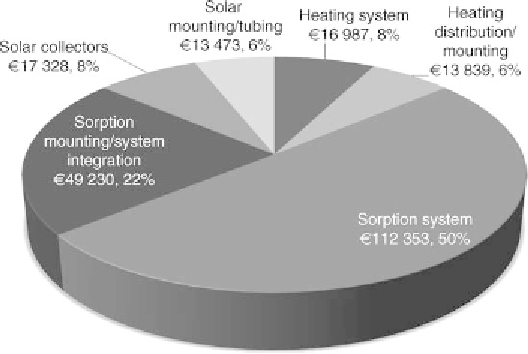Environmental Engineering Reference
In-Depth Information
Figure 5.44
Total investment costs for hardware, tubing and system integration for the solar-powered
desiccant cooling plant in Althengstett with 18 000 m
3
h
−
1
volume flow
for the unit control and its connection to the existing building management system.
The collectors were responsible for 12% of the total investment costs, but mounting
and system integration were expensive at 15%. In total the price per cubic metre and
hour of air flow was similar to the German system at
D
15 per m
3
h
−
1
.
From the total investment costs in the Maier factory project, an annuity of
D
26 070
capital-related costs results. If the funding for the DEC investment costs of
D
100 000
is taken into account, the annuity reduces to
D
14 122. Consumption-related costs for
heat, electricity and water occur together with the demand charge to provide a given
electrical power. In total the annual consumption costs for the desiccant cooling system
were calculated at
D
3147, about 40% less than for a conventional air-conditioning
system (see Figure 5.45). In the Spanish Mataro project, the savings calculated from
electrical peak power cost reduction were
D
4200 per year.
In addition, operation-related costs for maintenance and repair arise. Repair costs
are usually between 1 and 3% of investment costs, so for the calculations, 2% was
chosen. Maintenance costs are in a similar range: 76% of the total annual costs are
capital costs, the rest are operation and consumption costs (see Figure 5.46).
The annual heating energy saving through the solar thermal collector field of about
D
1500 can be subtracted from the total annual costs. The remaining cooling costs for the
investigated year with 34 710 kWh of cold production result in a specific cold price of
D
0.94 per kWh without funding and
D
0.6 per kWh including the investment funding.
By comparison, the costs for a conventional air handling unit with humidification and
an electrical compression chiller were calculated in this project at
D
0.65 per kWh.
The high price per kilowatt hour is largely due to the low total cooling demand in
the building. At a nominal power of the system of approximately 100 kW, the cooling

Search WWH ::

Custom Search